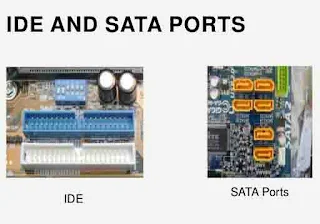Motherboards serve as the foundation of every computer system, connecting and coordinating all hardware components. This in-depth guide examines each critical part of modern motherboards, their functions, and how they work together to power your computer.
Processor Socket
The processor socket is where the CPU gets installed. Modern sockets vary between manufacturers:
| Intel Sockets | AMD Sockets |
|---|---|
| LGA 1700 (12th/13th Gen) | AM5 (Ryzen 7000) |
| LGA 1200 (10th/11th Gen) | AM4 (Ryzen 5000) |
| LGA 2066 (HEDT) | TR4/sTRX4 (Threadripper) |
Memory System
Modern memory standards:
- DDR5: 4800-6400MHz (latest standard)
- DDR4: 2133-3200MHz (previous generation)
- Dual/Quad channel configurations
- XMP/EXPO profiles for overclocking
Chipset Components
Modern chipsets handle:
- PCIe lane distribution (up to 28 lanes)
- SATA/USB connectivity (10Gbps USB 3.2 Gen 2)
- Networking features (2.5G/5G Ethernet)
- Overclocking support (on Z/X-series chipsets)
Storage Connectivity
Storage options include:
- SATA III: 6Gbps for HDDs/SSDs (backward compatible)
- M.2 NVMe: PCIe 3.0/4.0/5.0 slots (up to 128Gbps)
- U.2: Enterprise SSD connections (rare on consumer boards)
Expansion Slots
PCIe slot versions:
| Generation | Bandwidth | Common Uses |
|---|---|---|
| PCIe 5.0 | 128GB/s (x16) | High-end GPUs, NVMe SSDs |
| PCIe 4.0 | 64GB/s (x16) | Mid-range GPUs, NVMe SSDs |
| PCIe 3.0 | 32GB/s (x16) | Legacy devices, expansion cards |
I/O Ports
Modern I/O panel includes:
- USB: USB 2.0 (black), USB 3.2 Gen 1 (blue), USB 3.2 Gen 2 (red), USB-C (reversible)
- Video: HDMI 2.1, DisplayPort 1.4, sometimes legacy VGA/DVI
- Audio: 3.5mm jacks with HD audio (5.1/7.1 surround)
- Networking: 2.5G/5G/10G Ethernet (RJ45)
- Wireless: WiFi 6/6E antennas (on premium boards)
- BIOS Features: Flashback buttons, CMOS clear switches
Power System
Power delivery components:
- 24-pin ATX main power connector
- 4+4 or 8-pin EPS CPU power (sometimes dual 8-pin for HEDT)
- Additional PCIe power connectors for high-end GPUs
- VRM cooling (heatsinks) for stable power delivery
Front Panel Connectors
These essential connectors interface with your computer case's front panel:
- Power Switch: Turns the system on/off (momentary contact)
- Reset Switch: Hard reset button
- Power LED: Indicates system power status (usually 2-pin)
- HDD Activity LED: Shows storage drive activity
- Front Audio: HD Audio connector for headphone/mic jacks
- USB Headers: For front panel USB ports (USB 2.0/3.0/3.1)
- RGB Headers: For case lighting control (4-pin 12V or 3-pin 5V)
Note: Consult your motherboard manual for proper pin configuration as layouts vary between manufacturers.
BIOS/UEFI Chip
The BIOS/UEFI chip is responsible for:
- Hardware initialization during boot
- System configuration storage
- Hardware monitoring
- Boot device selection
- Graphical interfaces
- Mouse support
- Secure Boot functionality
- Faster boot times
CMOS Battery
The CMOS battery:
- Maintains BIOS settings when powered off
- Keeps the system clock running
- Typically lasts 3-5 years
- Commonly CR2032 coin cell type
Symptoms of a dead CMOS battery include reset BIOS settings and incorrect system time/date.
FAQs
How do I identify my motherboard model and specifications?
Check the printed text near PCIe slots or RAM area, use system information tools in your OS, or enter BIOS/UEFI to see model information. Manufacturer websites provide detailed specifications.What's the practical difference between chipset versions (Z790 vs B760)?
Z-series chipsets support CPU overclocking, have more PCIe lanes (up to 28), more USB ports (including 20Gbps), and often better VRMs. B-series are more budget-oriented with fewer features but sufficient for most users.How important is motherboard VRM quality for my build?
VRM quality becomes crucial with high-end CPUs (i9/Ryzen 9). More power phases (12+ for mid-range, 16+ for high-end) with proper cooling ensure stable performance, especially during overclocking or sustained workloads.Can I use DDR4 RAM in a DDR5 motherboard or vice versa?
No, DDR4 and DDR5 have different physical notches (preventing insertion), electrical requirements, and controllers. Some rare motherboards support both but with separate slots (not simultaneously).What motherboard size should I choose for my build?
- ATX (Standard): Full features, most expansion slots
- Micro-ATX: Compact but fewer slots, fits most cases
- Mini-ITX: Small form factor (1 PCIe slot), for portable builds
- E-ATX: Extended size for workstations/HEDT platforms















Post a Comment